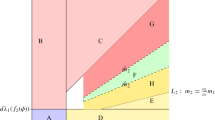Abstract
An analysis is given of a mathematical model of two predators feeding on a single prey growing in the chemostat. In the case that one of the predators goes extinct, a global stability result is obtained. Under appropriate circumstances, a bifurcation theorem can be used to show that coexistence of the predators occurs in the form of a limit cycle.
Similar content being viewed by others
References
Butler, G. J.: Coexistence in predator-prey systems. In: Burton, T. (ed.) Modeling and differential equations in biology. New York: Marcel Dekker 1980
Butler, G. J., Waltman, P.: Bifurcation from a limit cycle in a two predator-one prey ecosystem modeled on a chemostat. J. Math. Biology 12, 295–310 (1981)
Canale, R. P.: Prey relationships in a model for activated process. Biotechnol. Bioengineering 11, 887–907 (1969)
Canale, R. P.: An analysis of models describing predator prey interaction. Biotechnol. Bioengineering 12, 353–378 (1970)
Cheng, K. S.: Uniqueness of limit cycle for a predator-prey system. SIAM J. Math. Analysis 12, 541–548 (1981)
Drake, J. F., Tsuchiya, H. M.: Predation of Escherichia Coli by Colpoda Stenii. Appl. Envr. Microbiol. 31, 870–874 (1976)
Erle, D.: Stable closed orbits in plane autonomous dynamical systems. J. Reine Angew. Math. 305, 136–139 (1979)
Fredrickson, A. G., Stephanopoulos, G.: Microbial competition. Science 213, 972–979 (1981)
Hansen, S. R., Hubbell, S. P.: Single-nutrient microbial competition: Agreement between experimental and theoretical forecast outcomes. Science 207, 1491–1493 (1980)
Herbert, D., Elsworth, R., Telling, R. C.: The continuous culture of bacteria: A theoretical and experimental study. J. Gen. Microbiol. 14, 601–622 (1956)
Hsu, S. B., Hubbell, S., Waltman, P.: A mathematical theory for single-nutrient competition in continuous cultures of microorganisms. SIAM J. Appl. Math. 32, 366–383 (1977)
Hsu, S. B., Hubbell, S. P., Waltman, P.: A contribution to the theory of competing predators. Ecol. Mongr. 48, 337–349 (1978)
Hsu, S. B.: Limiting behavior for competing species. SIAM J. Appl. Math. 34, 760–763 (1978)
Jannash, H. W., Mateles, R. T.: Experimental bacterial ecology studied in continuous culture. Adv. Microb. Physiol. 11, 165–212 (1974)
Jost, J. L., Drake, S. F., Fredrickson, A. G., Tsuchiya, M.: Interaction of tetrahymena pyriformis, escherichia coli, azotobacter vinelandii and glucose in a minimal medium. J. Bacteriol. 113, 834–840 (1976)
Keener, J. P.: Oscillatory coexistence in the chemostat: A codimension two unfolding, SIAM J. Appl. Math. (to appear)
Koch, A. L.: Competitive coexistence of two predators utilizing the same prey under constant environmental conditions. J. Theoret. Biology 44, 378–386 (1974)
Marsden, J. E., McCracken, M.: The Hopf bifurcation and its applications. Berlin-Heidelberg-New York: Springer 1976
McGehee, R., Armstrong, R. A.: Some mathematical problems concerning the ecological principle of competitive exclusion. J. Diff. Eq. 23, 30–52 (1977)
Monod, J.: Recherches sur la croissance des cultures bacteriennes. Paris: Hermann 1942
Pike, E. B., Cuids, C. R.: The microbial ecology of activated sludge process. In: Sykes, G., Skinner, F. A. (eds) Microbial aspects of pollution. New York: Academic Press 1971
Sell, G.: What is a dynamical system? In: Hale, J. (ed) Studies in ordinary differential equations. MAA Studies in Mathematics No. 14, 1977
Smith, H. L.: The interaction of steady state and Hopf bifurcation in a two-predator-one-prey competition model. SIAM J. Appl. Math. 42, 27–43 (1982)
Stewart, F. M., Levin, B. R.: Partitioning of resources and the outcome of interspecific competition; A model and some general considerations. Am. Nat. 107, 171–198 (1973)
Tsuchiya, H. M., Drake, S. F., Jost, J. L., Fredrickson, A. G.: Predator-prey interactions of dictyostelium discordeum and escherichia coli in continuous culture. J. Bacteriol. 110, 1147–1153 (1972)
Veldcamp, H.: Ecological studies with the chemostat. Adv. Microbial Ecol. 1, 59–95 (1977)
Waltman, P., Hubbell, S. P., Hsu, S. B.: Theoretical and experimental investigations of microbial competition in continuous culture. In: Burton, T. (ed) Modeling and differential equations in biology. New York: Marcel Dekker 1980
Author information
Authors and Affiliations
Additional information
Research supported by NSERC Grant A-8130
Research supported by National Science Council of ROC
Research supported by NSF Grant MCS-8120380. A portion of this research was performed while the author was a Visiting Professor at the University of Southern California, Los Angeles
Rights and permissions
About this article
Cite this article
Butler, G.J., Hsu, S.B. & Waltman, P. Coexistence of competing predators in a chemostat. J. Math. Biology 17, 133–151 (1983). https://doi.org/10.1007/BF00305755
Revised:
Issue Date:
DOI: https://doi.org/10.1007/BF00305755




